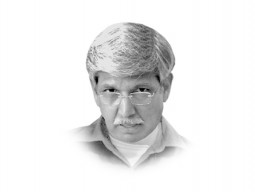
After a recent excavation in Bhanbhore, one thinks the history of Sindh needs scientific and serious research to determine how many sites truly tell the original history of the province. The recovery of three human skeletons raise further questions as to whether this region was destroyed as a result of a natural disaster or some other calamity. What happened then? A human invasion or another natural disaster?
Does it need more excavation? Yes, the excavation will continue as it is in its initial phases. If Bhanbhore was partially damaged, then the future will disclose a new and unique picture of this region. It may reveal that the city, which is mostly associated with folklore Sassui and sometimes referred to as the site from where Muslims invaded the subcontinent, is no less important than Moen jo Daro.
First, a nation who really cares about its history needs to preserve its heritage sites and then make efforts to explore what happened and how it became a mound of mud. But we’re different when it comes to talking about our rare sites. For instance, say, Moen jo Daro. It is in pathetic shape. The seriousness was disclosed when the Sindh Festival was launched from its ruins –– that narrates a beauty of 5,000 years.
A couple of years ago, an international conference on Bhanbhore was held on the location where dozens of vehicles squashed the remains. A tent for the conference was fixed at the site. People came, read, heard, looked at the site for a while and left; they never returned for more research.
Two teams from Italy and France, along with Pakistan supporters, spent days and nights and explored what we didn’t find for more than 50 years! So, do we really care about our culture and history? Doesn’t seem that way. And it’s not just Bhanbhore. From Moen jo-Daro to Kot Diji Fort, and from Makkli Graveyard to Ranikot Fort, not only do we not care, but also humiliate the labour of our own ancestors.
PPP’s patron-in chief Bilawal Bhutto Zardari introduced three Ps –– preserve, protect and promote –– while introducing the Sindh Festival. He pledged to protect all of Sindh’s heritage sites. Despite such claims, the situation before and after the festival remains the same: dismal. We need to reclaim our history since we were more civilised back then compared to today.
Published in The Express Tribune, March 8th, 2014.


































































COMMENTS (1)
Comments are moderated and generally will be posted if they are on-topic and not abusive.
For more information, please see our Comments FAQ